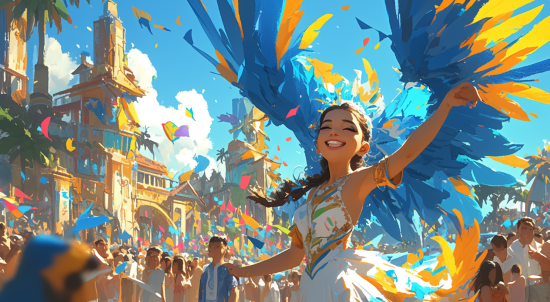Carnival in Brazil, also known as “Carnaval” in Portuguese, is one of the most famous and vibrant festivals in the world. It is a four-day celebration that takes place before Lent, the period of fasting and reflection in the Christian calendar. Carnival in Brazil is a time of joy, music, dance, and cultural expression, attracting millions of visitors from all corners of the globe. The highlight of Carnival in Brazil is the Rio Carnival, which is considered the largest and most iconic carnival celebration in the country. In this article, we will provide a complete guide to the Rio Carnival, from its history to its current form.
The history of Carnival in Brazil can be traced back to the 18th century when Catholic Portuguese settlers brought their traditions and customs to the country. The festival has evolved over the years, incorporating elements of African, indigenous, and European cultures. Today, Carnival in Brazil is deeply rooted in Brazilian culture and is a major part of the country’s identity. It is a celebration of diversity, creativity, and the Brazilian spirit.
The Rio Carnival, held in the city of Rio de Janeiro, is the most famous and extravagant carnival celebration in Brazil. It is an official holiday in the country and is held every year in February or March, depending on the date of Easter. The festivities begin on the Friday before Ash Wednesday and continue until Tuesday, also known as Fat Tuesday. The main events of the Rio Carnival take place at the Sambadrome, a 700-meter-long parade ground with grandstands on each side.
One of the most iconic aspects of the Rio Carnival is the samba parade, where various samba schools compete in elaborate and colorful costumes, music, and floats. Each samba school represents a particular neighborhood or community in Rio and spends months preparing for the parade. The samba parade is a visual spectacle, with dancers, musicians, and performers showcasing their skills and creativity. The competition is fierce, and the samba schools put on a show that is breathtaking and awe-inspiring.
Apart from the samba parade, there are also various street parties and block parties, known as “blocos” in Portuguese, that take place throughout the city. These street parties are open to everyone, and it is a great opportunity to experience the energy and liveliness of the Carnival in Brazil. The streets are filled with people dressed in colorful costumes, dancing to the rhythm of samba music, and enjoying the festive atmosphere.
However, it is not just about the parties and parades during the Rio Carnival; there are also cultural and religious events that take place. One of the most famous events is the Carnival ball, held at the Copacabana Palace hotel. It is a glamorous affair attended by celebrities, politicians, and members of high society. The Carnival ball is a chance to see some of the most extravagant and luxurious costumes of the event.
If you are planning to attend the Rio Carnival, it is essential to plan ahead and book your accommodation and tickets well in advance. The city gets extremely crowded during the festival, and prices tend to increase. It is also essential to take necessary precautions while attending the Carnival, such as avoiding carrying valuables and staying with a group.
In conclusion, Carnival in Brazil is a celebration of life, culture, and diversity. The Rio Carnival is a perfect representation of this spirit, with its colorful and vibrant festivities that attract millions of people from around the world. It is an experience not to be missed, and with this guide, you can now plan your visit and immerse yourself in the energy and excitement of the Rio Carnival.
The history of Carnival in Brazil can be traced back to the 18th century when Catholic Portuguese settlers brought their traditions and customs to the country. The festival has evolved over the years, incorporating elements of African, indigenous, and European cultures. Today, Carnival in Brazil is deeply rooted in Brazilian culture and is a major part of the country’s identity. It is a celebration of diversity, creativity, and the Brazilian spirit.
The Rio Carnival, held in the city of Rio de Janeiro, is the most famous and extravagant carnival celebration in Brazil. It is an official holiday in the country and is held every year in February or March, depending on the date of Easter. The festivities begin on the Friday before Ash Wednesday and continue until Tuesday, also known as Fat Tuesday. The main events of the Rio Carnival take place at the Sambadrome, a 700-meter-long parade ground with grandstands on each side.
One of the most iconic aspects of the Rio Carnival is the samba parade, where various samba schools compete in elaborate and colorful costumes, music, and floats. Each samba school represents a particular neighborhood or community in Rio and spends months preparing for the parade. The samba parade is a visual spectacle, with dancers, musicians, and performers showcasing their skills and creativity. The competition is fierce, and the samba schools put on a show that is breathtaking and awe-inspiring.
Apart from the samba parade, there are also various street parties and block parties, known as “blocos” in Portuguese, that take place throughout the city. These street parties are open to everyone, and it is a great opportunity to experience the energy and liveliness of the Carnival in Brazil. The streets are filled with people dressed in colorful costumes, dancing to the rhythm of samba music, and enjoying the festive atmosphere.
However, it is not just about the parties and parades during the Rio Carnival; there are also cultural and religious events that take place. One of the most famous events is the Carnival ball, held at the Copacabana Palace hotel. It is a glamorous affair attended by celebrities, politicians, and members of high society. The Carnival ball is a chance to see some of the most extravagant and luxurious costumes of the event.
If you are planning to attend the Rio Carnival, it is essential to plan ahead and book your accommodation and tickets well in advance. The city gets extremely crowded during the festival, and prices tend to increase. It is also essential to take necessary precautions while attending the Carnival, such as avoiding carrying valuables and staying with a group.
In conclusion, Carnival in Brazil is a celebration of life, culture, and diversity. The Rio Carnival is a perfect representation of this spirit, with its colorful and vibrant festivities that attract millions of people from around the world. It is an experience not to be missed, and with this guide, you can now plan your visit and immerse yourself in the energy and excitement of the Rio Carnival.



 admin
admin
















